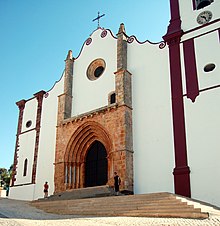Silves Cathedral

The Silves Cathedral (
History

The details about the foundation and building of Silves Cathedral are unclear. In the process of the Reconquista, Moorish Silves was conquered in 1189 by King Sancho I of Portugal, but since the city was retaken by the Moors in 1191, it is unlikely that a cathedral was built at this time. Only in 1242 was Silves definitely reconquered by Christian knights during the reign of King Afonso III, and it is believed that this king was responsible for beginning the construction of Silves Cathedral as the seat of a newly founded Algarve diocese.
The works proceeded with difficulty, and in 1352 the cathedral was damaged by a strong earthquake. In the 1440s, the cathedral workshop was given a great impulse by King Afonso V. This building campaign produced the apse with its three chapels, the transept and the main portal, in Gothic style, dating from the 1470s. The three-aisled nave was only finished in the early 16th century.
When
Economic difficulties and a diminishing population plagued the history of Silves in the 15th and 16th centuries, leading to the bishop staying for long periods away from Silves. The most notable of the bishops at this time was
The Great earthquake of 1755 struck a terrible blow to Silves and its cathedral and destroyed part of the nave. The building was repaired and modified, replacing the simple Gothic forms of the upper part of the main façade with Rococo volutes. The bell tower and the south portal are also 18th-century additions.
In the 20th century, an extensive renovation of Silves Cathedral suppressed many of the Baroque additions and returned the building to a more "medieval" look.
Art and architecture

From the outside, a striking aspect of Silves Cathedral is the contrast between the whitewashed surfaces of the walls and the red sandstone (grés de Silves) of the apse, windows and main portal.
The main portal, executed in the 1470s, is inserted on a stepped rectangular moulding (
Silves Cathedral is a
Gallery
-
Partial view of the cathedral from the outside
-
The choir's ceiling
-
The carved stone Sarcophagi Tomb of Crusader João Gramacho and his wife Ana Taborda
-
The stones of Vincent Raposa Viegas on the left, King John II in the middle, and bishop Fernando Coutinho, on the right
-
Tomb of nobleman Egas Moniz Teles
-
Details of the pillars and arches
-
Chapel of our lord of stations
-
Main portal
-
Lateral portal
-
Lateral view of the Gothic apse
Footnotes
- ^ "Mosque-Cathedral of Córdoba | cathedral, Córdoba, Spain | Britannica".
- ^ "IGESPAR IP | HERITAGE". www.igespar.pt. Archived from the original on 2012-03-03.
- ^ "Catedral de Silves / Sé de Silves". Direção-Geral do Património Cultural. Portuguese Government. Retrieved 17 March 2018.
- ^ Description of the Main Church of Portimão at the IPPAR website.
References
- Silves Cathedral on the IGESPAR website [1]
- General Direction of National Monuments and Buildings (DGEMN-Portugal) [2]
37°11′24″N 8°26′19″W / 37.1901°N 8.4387°W![]() Media related to Sé Catedral de Silves at Wikimedia Commons
Media related to Sé Catedral de Silves at Wikimedia Commons










